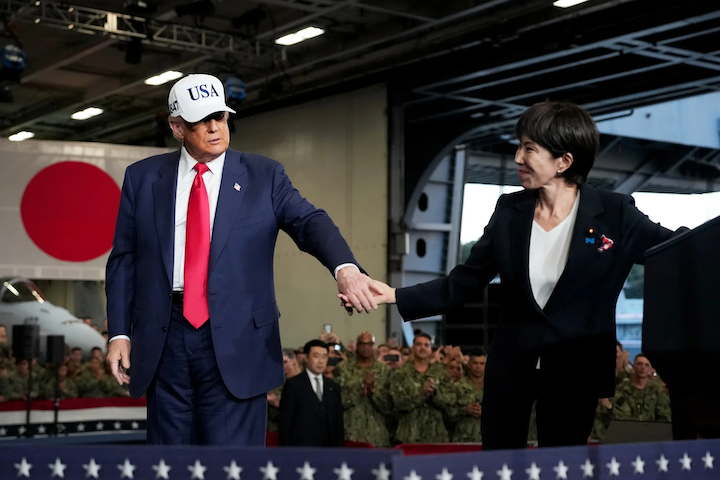Sanae Takaichi, 64, Japan’s first female Prime Minister, stepped into history as U.S. President Donald Trump descended into a 6-day tour of Asia in October and a “flurry of business deals that brought peace and prosperity to the region,” according to the White House. At the Asia-Pacific Economic Cooperation Summit (APEC), Trump met Chinese President Xi Jinping moments after filing a post. "Because of other countries testing programs, I have instructed the Department of War to start testing our Nuclear Weapons on an equal basis. That process will begin immediately.”
Across the ASEAN and APEC summits, the Trump Administration’s managerial brio equated to an invite to either largely invest, or incur a higher levy in the U.S. The dealmaking is not more complex than that. Thailand, Cambodia, Malaysia, South Korea, even China all lined up for a slight reduction to recently inflated tariffs or “truce.” But an Executive Order called “A New Golden Age in the U.S.-Japan Alliance” could be a ruse.
Recall in the aftermath of “Little Boy” — the first U.S. nuclear weapon detonated on Hiroshima, Japan in 1945 — the backlash in which Canada and the U.K. stepped up and called for an international conference on nuclear disarmament. The first binding nuclear treaties were signed thereafter, e.g., The Partial Test Ban Treaty (1961) and Nuclear Non-Proliferation Treaty (1968) splintered into a cacophony of treaties on non-proliferation (NPT), disarmament (CTBT), arms control (New START, ABM), and others which sought and failed to abolish all nuclear weapons (TPNW).
Conversation ensued about the peaceful use of nuclear energy; the physical protection of nuclear material; even the regulation of nuclear activities remain hot topics at court circulars whilst nuclear-armed states continue to modernize, expand, and test their arsenals. While 9 nations have nuclear weapons — 🇺🇸 🇷🇺🇨🇳🇬🇧🇫🇷🇮🇳🇵🇰🇮🇱🇰🇵 — the US remains the first and only nation to ever use nuclear weapons in armed conflict.
Though Trump airdropped the post into the meeting with Xi, it was more likely a response to President Vladimir Putin’s recent claim that Russia had “conducted a successful test of a new atomic-powered and nuclear-capable underwater drone.” Putin signs off with a zinger. “This weapon cannot be intercepted.” Trump doubles down on Air Force One: "I see them testing and I say, well, if they're going to test, I guess we have to test.”
"China hopes the U.S. will earnestly fulfill its obligations under the CTBT, and honor its commitment to suspend nuclear testing," Guo Jiakun reacts in Beijing. Perhaps because the Taiwan Strait, a Chinese invasion, and their allies response could conceivably draw the world’s 10 most powerful militaries into direct conflict. One can cobble together from headlines how conflicts in Israel and Ukraine or Vietnam even say can begin as regional conflicts, and can escalate via U.S. and foreign military aid. A world war is something more. John F. Kennedy enlightens the United Nations in 1961:
Every man, woman and child lives under a nuclear sword of Damocles, hanging by the slenderest of threads, capable of being cut at any moment by accident or miscalculation or by madness. The weapons of war must be abolished before they abolish us.
"The weapons of war must be abolished before they abolish us."
The phrase first appears in 1914 when the biologist/philosopher Ernst Haeckel wrote in the Indianapolis Star: “There is no doubt that the course and character of the feared European War... will become the first World War in the full sense of the word.” Others had used the term gratuitously, but it was Haeckel who observed how two coalitions can splinter into global implications and create world conflict.
Behind the scenes at APEC lied a scrappy infighter, and perhaps the most conservative PM since WWII. Publicly, Takaichi signed on to an “Implementation of the Agreement Toward a NEW GOLDEN AGE for the U.S.-Japan Alliance,” pledging a $500 billion U.S.-Japan expenditure commitment with the U.S. That in exchange for keeping U.S.-Japan tariffs at 15% for now. Their $500 billion pledge is coincidentally or not the same size as their tax revenue.
Privately, Takaichi has indicated she’ll have another look; criticizes the U.S.-Japan Security Treaty; advocates her predecessor’s “Strong Japan" to accelerate growth and defense spending to 2%; and fully intends to revise Japan's pacifist postwar constitution.
As Japan’s first female PM in history shatters the glass ceiling, she picks through the shards or lessons of Japan’s national 9.4 trillion debt (the highest in the Indo-Pacific) and pieces together a promise of fiscal prudence and mandate for growth. An evolving security system and military are diluting Japan’s pacifist norms, and she’s on track to a redesign of Japan’s economy, national defense, security and intelligence community so as to “take Japan back from its constraining postwar regime.”
Japan will realign Indo-Pacific relations by updating its "Free and Open Indo-Pacific” (FOIP) strategy, strengthening security cooperation, focusing on economic and development partnerships, and engaging in nuanced diplomacy to reinterpret international norms and a rules-based order. In sum, Takaichi will exploit her trusted partners to provide a third option for nations caught in the crosshairs of the US and China. Enter Taiwan.
The One China Principle asserts there is only one People’s Republic of China (PRC), and that Taiwan is an inalienable part of the PRC’s territory. The Republic of China (ROC) repudiates this claim, and instead declares themselves a sovereign nation. The Taiwan Relations Act (1979) established substantial but non-diplomatic U.S.-Taiwan relations. It mandates U.S. security interests in the region; supplies defensive arms to Taiwan; and considers any effort to determine Taiwan's future by non-peaceful means a threat to peace and security in the Western Pacific. Bonus, U.S. trade with Taiwan reached approximately $186 billion in 2024.
But it’s China’s chokehold on critical rare earth minerals — and the lone processor of rare earth upon which the entire world relies — means the world is beholden to the raw materials, manufacturing capacity, and hub of global supply chains called “The World’s Factory.” If but for Nvidia and Intel. If or when Chinese companies acquire advanced or even semi-advanced A.I. microchips from US manufacturers — or can regulate rare earth upon which AI is created — the PRC will in turn modernize their military (PLA) to prevail in the Indo-Pacific. Moreover, Global Militaries are increasingly beholden to A.I. technology to protect and defend Authoritarian Governments (60), Flawed Democracies (46), Hybrid Regimes (36), and lastly Full Democracies coming in at (25).
Taiwan is the tipping point, and Japan at present a talking point. If Europe was woefully late to Ukraine, it can fairly be said that the world’s two largest superpowers have a long game. Will free nations of the world allow Taiwan, a beacon of democracy, to be enveloped by authoritarian China?
Xi and Takaichi met on the sidelines at APEC amidst deep rifts on the economy, national security, and, yes, Taiwan. “The world — including China — is undergoing major changes not seen in a century, and various instabilities are emerging,” Xi said. Despite the nearly $300 billion in trade between them in 2024, Takaichi this week stated that “a Chinese attack on Taiwan could be a survival-threatening situation for Japan.”
Senior Colonel Jiang Bin, a spokesman for the Ministry of National Defense, reacts to Takaichi’s remark on Friday. “Japan will pay a heavy price if it interferes in the Taiwan Strait by force.”
Thats because our newcomer is a China hawk, with a declared ambition to "bring Japan back to the top of the world.” China’s grey-zone tactics including coast guard patrols, damage to undersea cables, intelligence gathering balloons and missile tests await the arrival of Hai Kun: the first indigenous submarine commissioned into the Republic of China Navy.
Hai Kun (SS-711) represents the naval defense and technological independence of a country not widely recognized by the world as a sovereign state. That she’s named after a stealthy, elusive, and hard-to-detect mythological sea creature sets the stage for an encounter, miscalculation, and a defining first act of madness.
Archives










